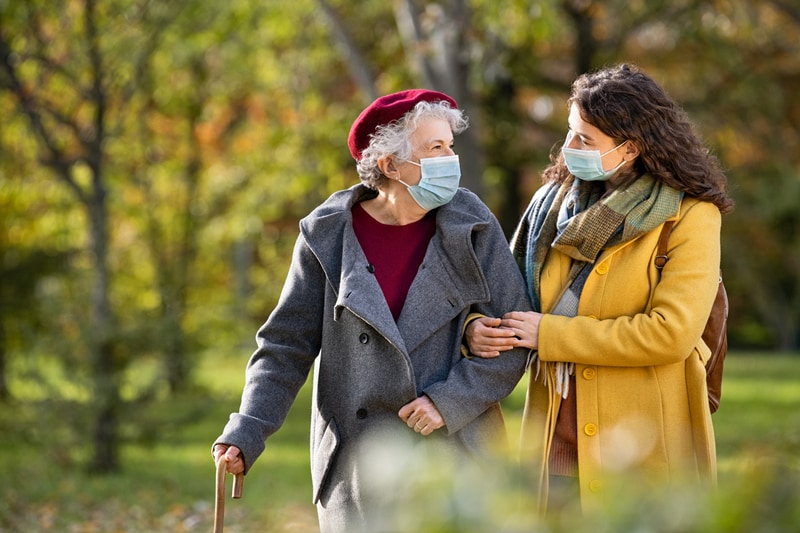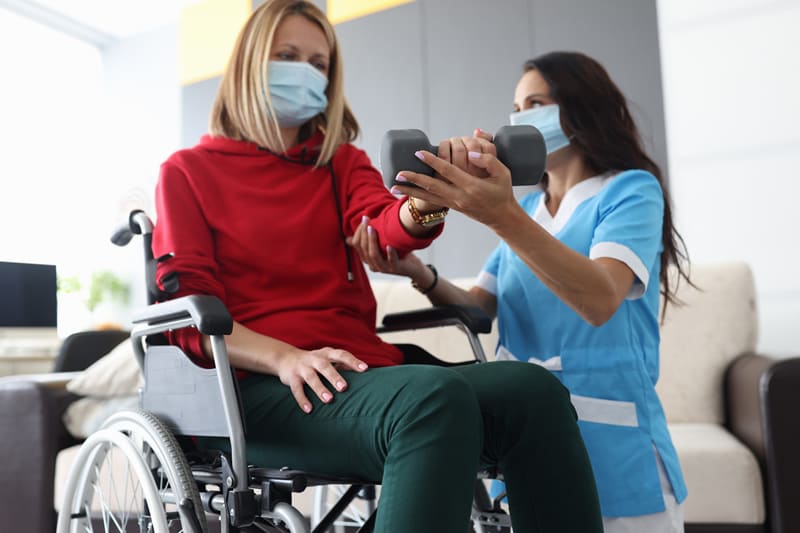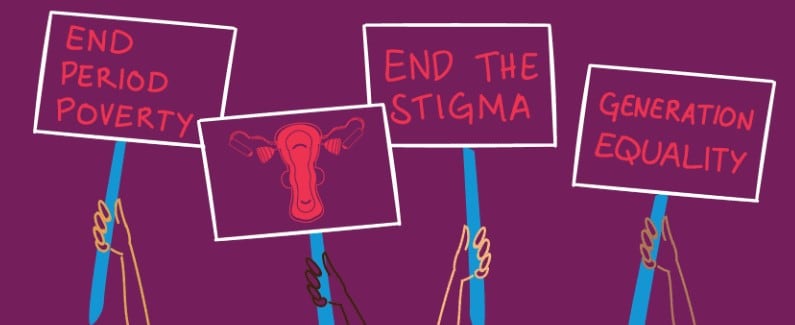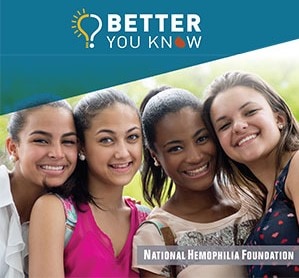Seven Facts to Know about Women’s Health
March 22, 2022
Women face diverse and unique health concerns across the lifespan which may affect their overall health and wellness. Learn how some of these health conditions and life challenges impact the lives of women and girls each year.

Two out of every three caregivers in the United States are women.
Women who are caregivers are at greater risk for poor physical and mental health, including depression and anxiety. The COVID-19 pandemic has added even more stressors to the role of caregiving. It is important for caregivers to maintain a healthy lifestyle, manage stress, and reach out for support as needed, especially during COVID-19.
- Ways to help maintain healthy behaviors include participating in regular exercise, practicing good sleep habits, and avoiding excessive alcohol.
- To help manage stress, caregivers should take pauses when needed, make time to unwind, and consider respite care for short-term relief from caregiving.
- Recognize when you need more help. Support groups provide a safe place for people in similar situations to find comfort and find out about local resources. Learn more about coping with stress during COVID-19.

About 1 in 4 women in the United States have a disability.
Women with disabilities need the same general health care as women without disabilities. They may also require additional care to address their individual and specific needs. The most common cause of disability for women is arthritis (i.e., osteoarthritis, rheumatism, fibromyalgia, lupus). Many women with disabilities may not receive regular health screenings as recommended, such as mammograms or a Pap test.
Adults with disabilities report experiencing frequent mental distress almost five times as often as adults without disabilities. Frequent mental distress is associated with poor health behaviors, increased use of health services, mental disorders, chronic disease, and limitations in daily life.
- Having a disability does not mean a person can’t be healthy.
- Being healthy means getting and staying in good physical, mental, and emotional health so you can lead a full, active life. That means having the information and tools to make healthy choices and knowing how to prevent illness.
Good menstrual hygiene practices are essential to gynecologic health, mental health, social connections, and career performance. Globally, millions of women and girls lack access to clean menstrual hygiene products and face challenges in maintaining their menstrual hygiene in a private, safe, and dignified manner. Being unable to afford menstrual hygiene products is a reality for many women and girls who menstruate. Women and girls who do not have proper and adequate resources to manage their monthly cycle may also face stigma and embarrassment.
- Private spaces should be created in homes and communities to maintain safe and healthy menstrual hygiene practices and help normalize conversations and support the healthy management of menses.
- Policy considerations to address period poverty may include readily available high-quality menstrual products at no cost in public spaces such as schools, prisons, homeless shelters, and healthcare facilities.


Don’t Miss the Signs. Bleeding Disorders in Women & Girls: Screening, Testing, and Coordinating Care.
Heavy menstrual bleeding, also known as menorrhagia, affects more than 10 million American women each year, or one out of every five women. Heavy menstrual bleeding may be the most noticeable symptom of a bleeding disorder that can be treated.
- Use the tools below to check for signs and symptoms of a bleeding disorder.
- Take an online bleeding disorder risk assessment to determine if you may be at risk for a bleeding disorder.
- Use a chart to track period cycles over a few months to help determine if there is heavy menstrual bleeding. A chart helps to track how many days periods last and how much bleeding is taking place during that time.
- Make an appointment with a healthcare provider to discuss any potential symptoms of a bleeding disorder.
- Be prepared for the visit and share as much information as possible when you speak to a healthcare provider. Consider helpful resources that you can complete ahead of time and bring to your appointment like a menstrual chart or healthcare diary to help you prepare for the visit.
- Talk openly about any symptoms to ensure a proper diagnosis for the best treatment options.
- Read real stories of women living with bleeding disorders.
Sexually transmitted diseases (STDs), also known as sexually transmitted infections (STIs), are very common. Millions of new infections occur every year in the United States. STDs pass from one person to another through vaginal, oral, and anal sex.
STDs don’t always cause symptoms or may only cause mild symptoms. Therefore, it is possible for someone to have an infection and not know it. Anyone who engages in unprotected sexual behaviors should get tested for STDs. All STDs are treatable with medicine, and some are even curable.
Chlamydia and gonorrhea, for example, are common STDs that can be easily cured. But, if not treated, they can cause pelvic inflammatory disease (PID). PID can lead to long-term pelvic pain, inability to get pregnant, and potentially deadly ectopic pregnancy (pregnancy outside the uterus). People with syphilis can also pass the infection onto their baby during pregnancy, but timely testing and treatment can protect the health of parent and child. When prescribed medication to treat an STD, it is important to take all the medicine exactly as the doctor prescribes.
- STDs are preventable. Know how to protect yourself and your sex partner(s) from STDs.
Women with a disability are at greater risk of experiencing rape than women without a disability. An estimated 2 in 5 (39%) female victims of rape had a disability at the time of the rape.
Intimate partner violence (IPV) can range from one episode of violence that could have lasting impacts to more constant and severe episodes over multiple years. IPV can include behaviors such as physical and sexual violence, stalking, and psychological aggression. There are many negative health outcomes associated with IPV. These include a range of conditions affecting the heart, digestive, reproductive, muscle and bones, and nervous systems, as well as mental health problems such as depression and symptoms of posttraumatic stress disorder (PTSD).
- To prevent intimate partner violence, it is important to understand and address factors that put people at risk for or protect them from violence.
- To promote healthy, respectful, and nonviolent relationships, communities can help prevent the harmful and long-lasting effects of IPV on individuals, families, and communities.
Deaths from drug overdose continue to contribute to overall mortality and the lowering of life expectancy in the United States. As women continue to struggle with opioid and substance use disorders, it is important to be informed about proper medication use. Women should make sure to discuss all medications (including over-the-counter) with a healthcare provider and only use medications as directed.
- Learn about helpful resources and how to start the conversation with a healthcare provider about the risks of opioids.
- Consider all available options to help prevent opioid misuse and opioid use disorder.
If you or someone close to you needs help for a substance use disorder, talk to your doctor or call SAMHSA’s National Helpline at 1-800-662-HELP or go to SAMHSA’s Behavioral Health Treatment Services Locator.
The CDC Office of Women’s Health (OWH) promotes public health research, evidence-based programs, policies, and strategies to improve the health and safety of all women and girls. The Office serves as a central point for women’s health and raises visibility of risk factors and other conditions that impact health. OWH was established in 1994 and authorized by the Patient Protection and Affordable Care Act in 2010.